The Juno Beach Centre is different to many of the other museums & memorials on the Normandy coast in that its focus is not so much on ‘what happened here?’, as ‘how and why were the Canadians here?’.
“The goal is not to be too technical,” says Louis Lebel, the Juno Beach Centre’s Visitor Services Manager. “The goal is for people to come in here and discover how & why Canada had one million men in uniform to fight a war they didn’t have to fight.”

As a Lieutenant in the Royal Canadian Artillery, Garth Web was one of the frightened young men who came ashore on Juno Beach on June 6th 1944. He returned for the 50th Anniversary events in 1994 and noted that there wasn’t any kind of interpretive centre to mark the role the Canadians had played on D-Day, nor to explain the war effort made by all Canadians, civilian and military alike, both at home and on the various fronts during the Second World War. He set about putting that right. Over 9 years he led the campaign to raise some $10m, secured the land right on the beach at Courseulles-sur-Mer and built the Juno Beach Centre. It opened in 2003.
The Canadians at Juno Beach
It was the 3rd Canadian Infantry Division and the 2nd Canadian Armoured Brigade that assaulted Juno Beach on 6 June¹, capturing the coastal towns of Graye-sur-Mer, Courseulles-sur-Mer, Bernières-sur-Mer and part of Saint-Aubin-sur-Mer.
That day, 14,000 of the 135,000 allies who landed or parachuted in Normandy were Canadians. After the United States and Great Britain, Canada contributed the largest number of troops to the D-Day invasion. Canadian casualties totalled 1,074 men, of whom 359 were killed.
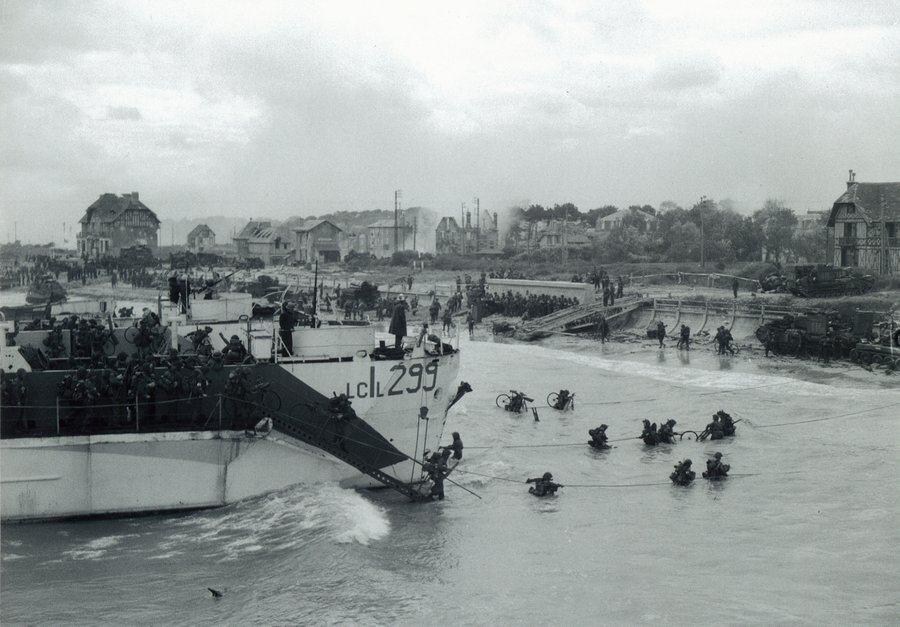
The 10-week campaign in Normandy resulted in over 18,000 Canadian casualties; of these, approximately 5,500 were killed. Most are buried in the two Canadian cemeteries at Bény-sur-Mer and Cintheaux.
What’s in the Juno Beach Centre?
There are five gallery areas, plus a temporary exhibition hall, and the Centre extends outside where there are memorial pillars (“kiosks”) to the fallen, some military artifacts (a 25-pounder Mark II Quick Firing Field Gun and a 40mm BOFOR gun) and a German bunker buried in the dunes which you can visit with a guide.
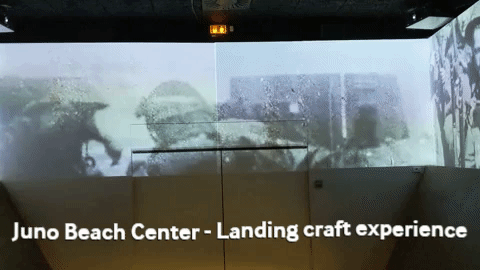
The tour through the Centre starts with a short landing craft experience. You stand in a group in a landing craft shaped room with scenes of the landing projected around you, and then the door opens into the first gallery which covers ‘Canada in the 1930s‘ and explains the Canadian psyche and political background to both World Wars.
When the First World War began, Canada was part of the British Empire and had little choice but to join. However, the cost in Canadian lives fuelled a desire for independence and in 1926 Britain acknowledged (the Balfour Declaration) she would give up her legislative powers over the Dominions, and did so in 1931 (Statute of Westminster).
So when Britain declared war on Germany in 1939, Canada didn’t have to commit to war, nevertheless loyalty to Britain still existed, and within a week Canada became an ally.
The second gallery, ‘Canada Goes to War‘ examines how the whole of Canada is mobilised over the course of the war, both in military campaigns and on the home front.
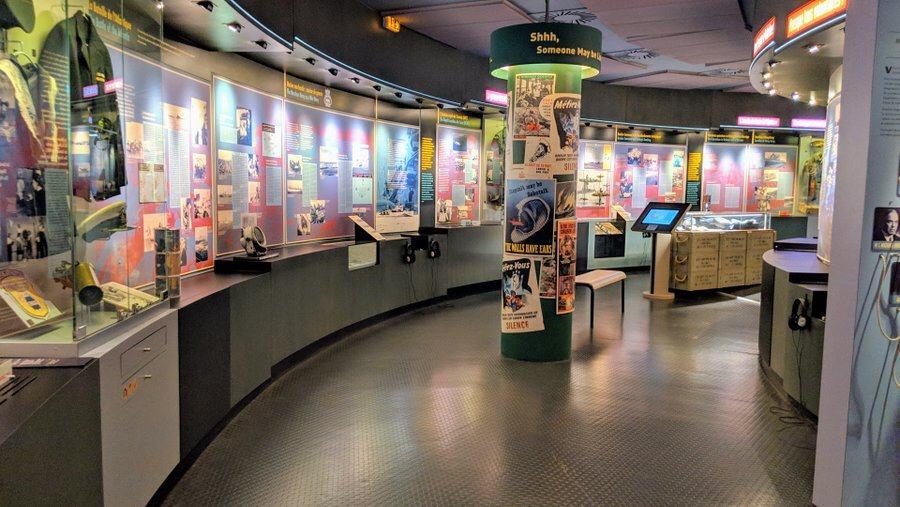
What’s interesting is that Canada’s quick declaration of war meant that Canadian troops arrived in Britain before there was much to do. The soldiers who landed at D-Day had come over to Britain in 1941, so they had been training, training and training for three years.
The difference training made could be seen in the Canadian tank crews. The Americans came over and went to straight into battle in North Africa (Operation Torch), by the time it came to Overlord many of their tank crews had some battle experience but were also mixed up with new replacements and hadn’t had time to fully train. In Normandy if for example an American driver was killed or injured they might abandon the tank, whereas the Canadians could keep going. They were fully trained so every crew member could drive the tank.
The third & fourth galleries are quite small…
The third gallery is the ‘The Roads to Victory‘ gallery covering the main Canadian campaigns in Europe from D-Day to VE Day.
In the centre of the room are video testimonies from soldiers who were there, talking about their experiences. Around the outside of the room there are displays and artifacts covering many of the activities and units that don’t get as much attention as the frontline units, such a signallers, engineers, medical and logistics.
It’s worth remembering that the museum is a privately funded, not-for-profit, organisation so they don’t have a budget to buy artifacts. Everything in the museum has been donated. Often by ex-servicemen who have visited and say “Hey, I might have something of interest for you”!
And there are some nice items. I particularly like the Bailey Bridge Construction training kit.
The personal storytelling runs into the ‘Some Came Back, Others Did Not‘ gallery, which tells the personal stories of Canadians who lived during this period.
On the ‘not come back side’ there’s a set of drawers with personal items and stories of some of those who fell.

One of the other unique characteristics of the Canadian troops was that they were nearly all volunteers.
Unlike the other Allies, the government, sensitive to the views of the Québécois, were very reluctant to introduce conscription. Eventually in April 1941 the National Resources Mobilization Act (NRMA) authorised conscription for home defence only. It wasn’t until the Japanese entered the war that the NRMA was amended to allow conscription for overseas service, but by then there were enough volunteers.
After the losses in Normandy the government again came under pressure to send conscriptees to Europe and in the end some 13,000 NRMA men eventually left Canada, but only 2,463 reached units in the field before the end of the fighting. Just 69 conscripted Canadians died in battle.
So, what have we learned? That Canadian military was probably the most ‘professional’ of the all the Allies – in that they were enthusiastic volunteers, fully trained.
The last room ‘Faces of Canada Today‘ is an uplifting space, large and light, that focuses on modern day Canada mostly with the school groups in mind. A set of totem poles have audio headphones around their base where visitors can listen to modern day Canadians talking about their lives.
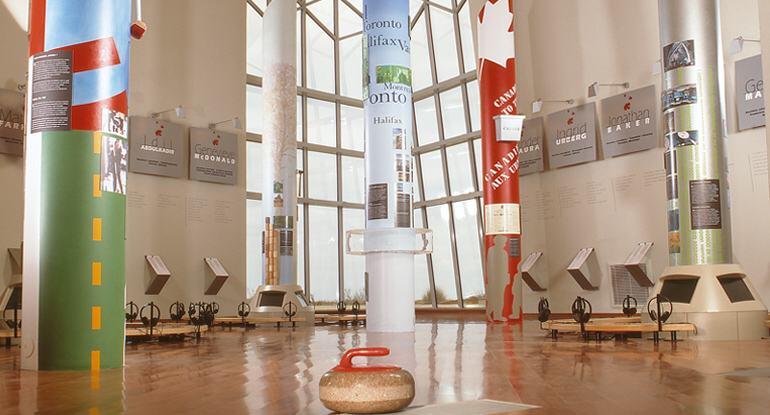
The Juno Centre – Cinema
The Juno Centre also has a small theatre that shows a 12-minute movie called “They Walk With You” about the Canadians’ experience in Normandy. It’s a unique movie. Much of the footage is owned by the Juno Beach Centre and can only be seen here. There’s no DVD or Youtube version. It runs every quarter-hour.
Juno Park – The German Bunkers
Outside the Juno Beach Centre lies the remains of a German observation post that communicated and coordinated fire with local batteries & bunkers. Next to it, joined by a covered passage, is another bunker that was only uncovered in 2010. This is the underground Command Post of the 6th Company, 736th Infantry Regiment of Hauptmann Grote.
There’s one nice touch in the commander’s office. He had a window opening cut into the wall to let light in… which kinda defeats the object of a bunker in the first place!
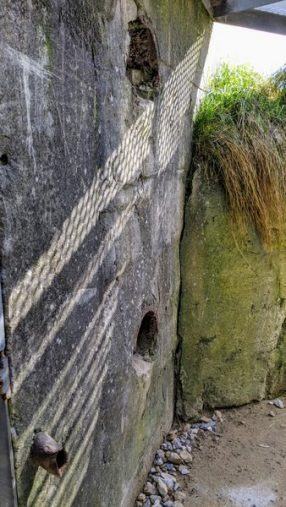
I also rather like the grenade trap on the outside wall of the observation bunker, by the entrance at the back. There you are, attacking the bunker. You pop your grenade through the rather inviting hole by the steel door… and it rattles down to appear out of another hole at your feet!
Another recent discovery (2010) nearby, is a German machine gun emplacement (‘Tobruk’), which was opened to the public this year.
The Centre offers guided tours of these installations and the beach area, where they will talk through the events of that day on Juno in 1944, which had 1200 casualties – the second highest after Omaha Beach.
Temporary Exhibition – Great Women during the War
I’ll be honest, this exhibition looked a little dull at first. The colours were muted, there seemed to be just a lot of photos with text and a few desultory artifacts. Actually, on closer inspection there were some interesting nuggets in here. The women (16 of them) are Allied & Axis nationalities. Some were heroic participants (nurses, spies) others were just caught up in the war (factory workers, wives & mothers). Some were tragic, like the German artist Oda Schottmueller, who was executed for criticising the Nazi regime. Some were un-noticed like Mary Ziniuk & Mary Holland who, like thousands of Canadian women, made things like scarves & socks for soldiers, and sold war saving stamps to raise funds for the military. “I double-checked this because I didn’t believe it,” says Louis Lebel, “but the figure is correct. These women raised the equivalent of three billion modern day Euros during the war!”
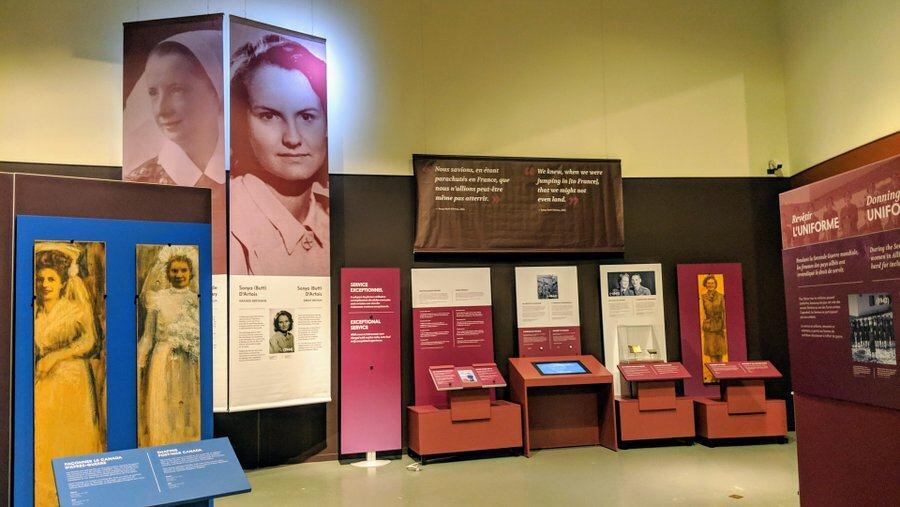
The Great Women during the War exhibition will run till 31st Dec 2020.
¹ Plus 8,000 Brits! The British 1st Corps (mostly combat engineers) also landed on Juno Beach, further to the west. Courseulles itself was liberated by the 7th Canadian Infantry Brigade, consisting of the Regina Rifles, the Royal Winnipeg Rifles, and the Canadian Scottish regiments, supported by the First Hussars Tanks, the 12th and 13th Field Regiments and the Royal Canadian Engineers. By the evening of D-Day, the Canadians were firmly established some 12 kilometres inland.
D-Day Normandy Posts
Declaration: I was on a self-driving press trip as a guest of the Normandie and Calvados tourist offices. Museum entry was complementary.
Factbox
Website:
Juno Beach Centre
Getting there:
Voie des Français Libres, BP 104
14470 Courseulles-sur-Mer
France
When you drive into Courseulles-sur-Mer, head for the west side of the harbour and follow signs for the Juno Beach Centre. The museum is right on the waterfront on the west side of the harbour entrance.
Entry Prices 2020:
| Adult | Reduced Rate * | |
|---|---|---|
| Juno Beach Centre | € 7.50 | € 6.00 |
| Temporary Exhibit Only | € 4.00 | € 4.00 |
| Juno Park Only** | € 6.00 | € 5.00 |
| Juno Beach Centre + Juno Park** | € 12.00 | € 10.00 |
| * Children – Between the ages of 8 and 18. Students – in elementary school, secondary school, college or university Teachers Military – In uniform or civilian clothing Unemployed Individuals ** 6 years and up. |
||
| Family Pass (max 2 adults and 3 children over 8 yrs) Juno Beach Centre: €23 JBC + Juno Park: €35 |
||
| Free for WW2 Veterans, WW2 widows, war disabled and accompanied children under 8 | ||
Opening Hours:
| Summer 1st Apr – 30th Sep |
9:30am to 7:00pm |
| Winter 1st Nov – 28th Feb |
10:00am to 5:00pm |
| Mar – Oct | 10:00am to 6:00pm |
| Jan | Closed |
| Closed 25th Dec, 5th & 6th June | |

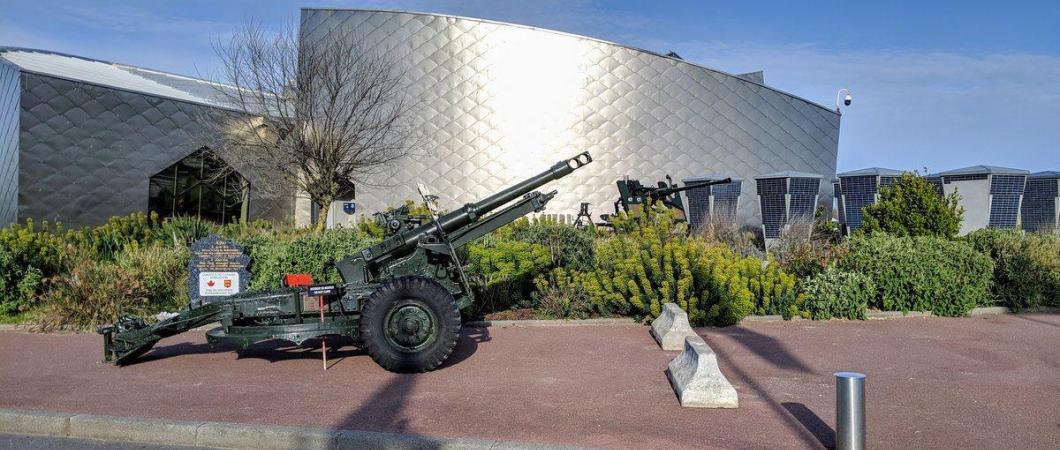
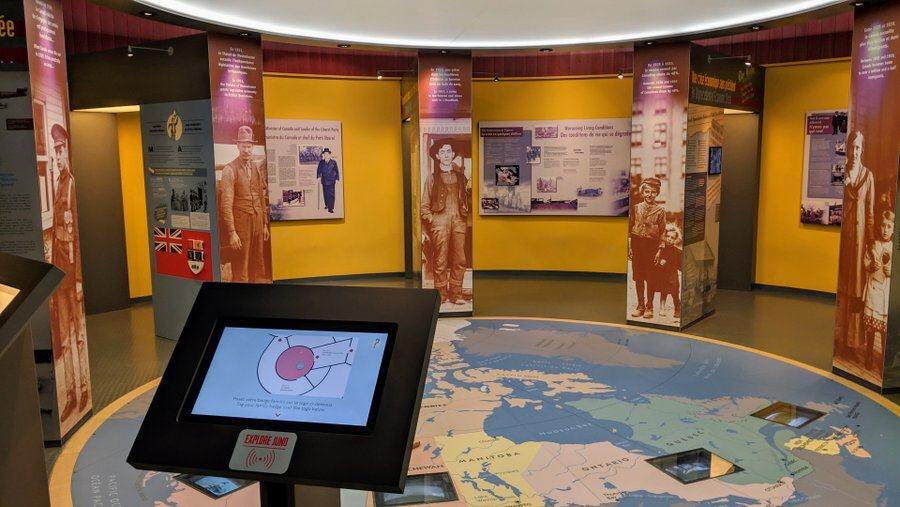
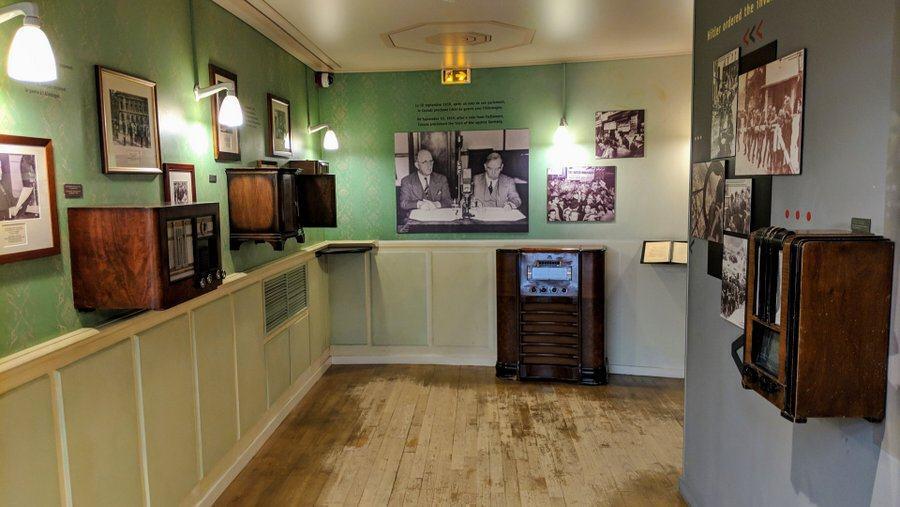

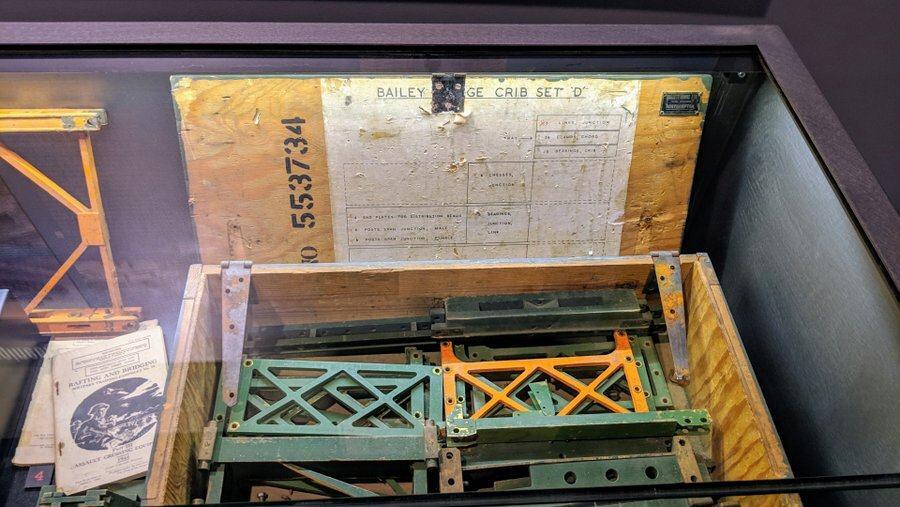
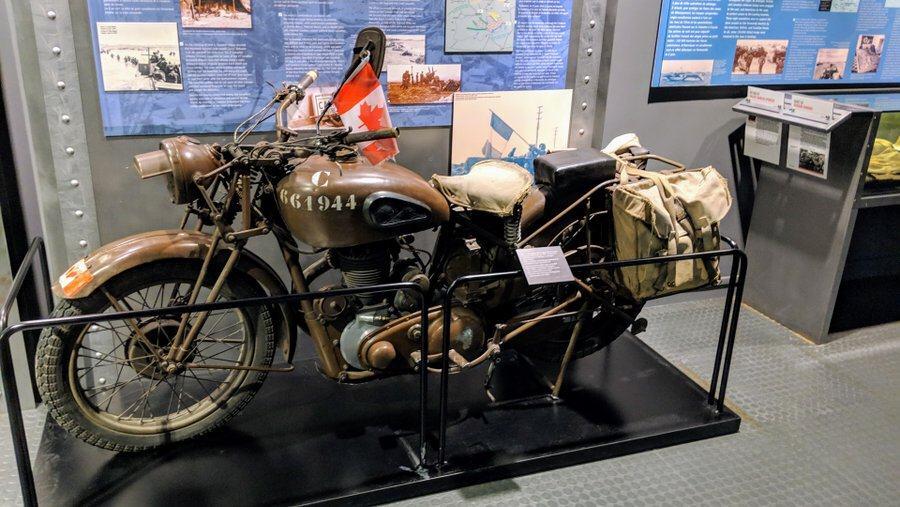

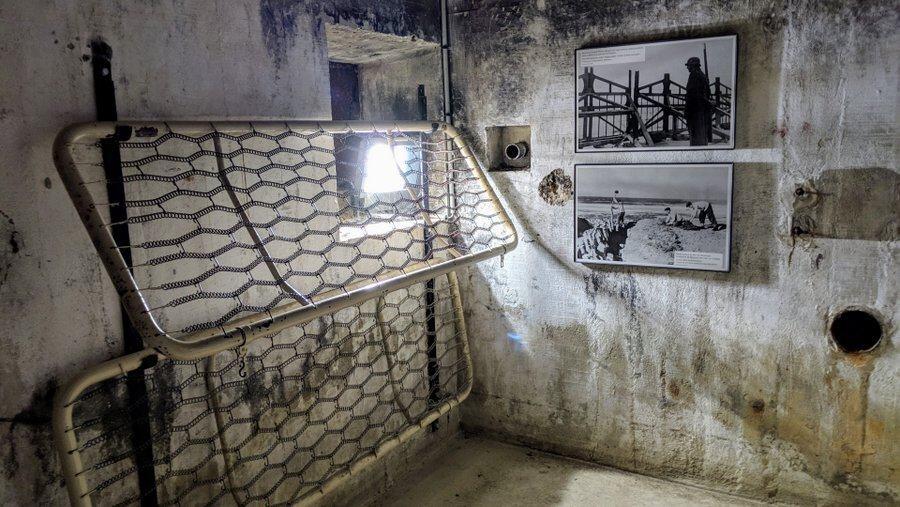
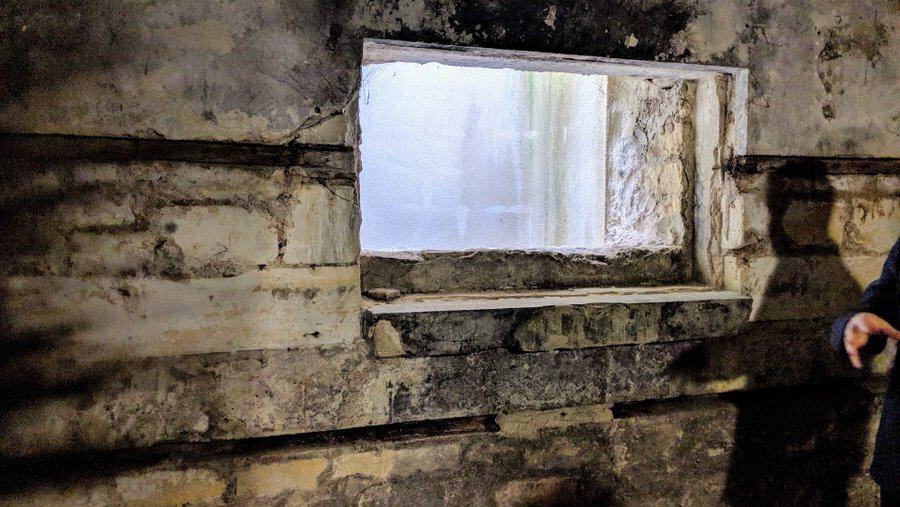



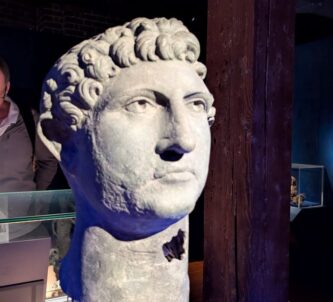
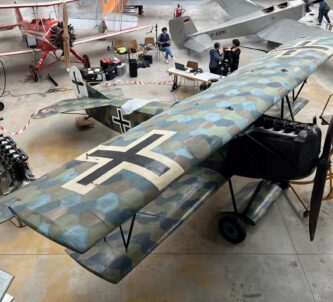

Thank you for acknowledging that significant numbers of British troops also landed on Juno, my grandfather amongst them. Beach groups 7 and 8 landed on Mike and Nan sectors. They included Royal Marine Commandos, infantry, engineers, pioneers, medics and ordnance. Men of my grandfather’s company of pioneers landed with the second wave and cleared mines and other obstacles from the beach.
The Royal Pioneer Corps were the unsung heroes – the glue that keeps the rest together. 🙂